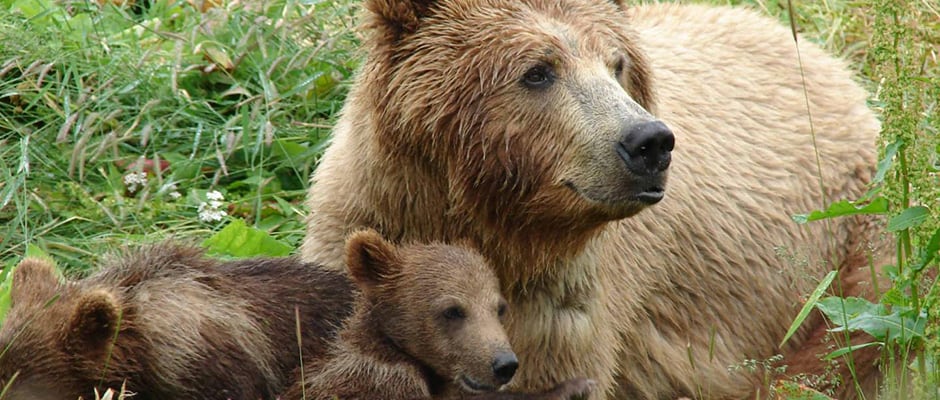Share this article
What a Grizzly Bear’s Hair Reveals about Its Diet
Just a single strand of hair can provide insight into the cuisine a grizzly bear has delighted in for the past few months based on the amount of mercury and other trace metals in its system.
In a recently published study, researchers in the United States and Canada implemented a technique that uses a laser on individual grizzly hairs to determine the presence of mercury and other heavy metals in grizzly bears’ diets, which is relative to the amount of salmon they have consumed. Researchers say this can help them understand if the bears — listed as threatened under the Endangered Species Act — are getting enough of the right foods and can help managers monitor if there is a healthy amount of mercury in the bears’ systems.
Researchers have been using an earlier version of this technique for the past 20 years to determine the diets of bears including grizzlies (Ursus arctos), black bears (Ursus americanus) and European cave bears (Ursus spelaeus), in different ecosystems and during different time periods, according to Charles Robbins, a Washington State University wildlife biologist and director of the WSU Bear Research, Education and Conservation Center, as well as a co-author of the study published in the journal Science in the Total Environment. In previous studies, Robbins and other researchers tested individual hairs for carbon and nitrogen to determine sources of protein and energy in the bears’ diets. However, this time rather than finding out which foods make up what percent of the bear’s diet, they focused on testing the hair for heavy metals to help determine the weight of the foods that contain heavy metals such as salmon that grizzlies consume.
“[This] allows managers to identify the important groups of foods for bears in their ecosystems and thereby focus on perpetuating those,” said Robbins, a member of The Wildlife Society. “The technique will also allow managers to determine if bears are consuming foods provided by people that have a different carbon signature, for example garbage, bird seed or several agricultural crops, or if they are consuming truly wild food.”
Lead author of the study Marie Noel and her team including Robbins sampled 20 wild grizzly bears across British Columbia as well as five captive grizzlies at the Washington State University Bear Center to determine the amounts of trace metals in their hair. The researchers used the WSU bears as a control group by feeding them low mercury foods and then high mercury foods such as salmon migrating up the Columbia River and Yellowstone Lake cutthroat trout during the time of year when wild bears would consume these foods. “Just as soon as they started eating salmon or other foods that are higher in heavy metals like mercury, the concentration starts rising in the hair,” Robbins said. “[It] shows up very quickly.”
They then analyzed hair from wild grizzly bears across British Columbia and compared their mercury levels to the captive bears’. Noel said in the wild bears, the increase of mercury found in their hair coincided with the return of salmon. They found that the wild bears had higher mercury levels than the captive bears due to their high salmon consumption.
To test the individual hair strands, the researchers used a laser to burn along the middle of the hair shaft. The gas created from this was then sent to a mass spectrometer where carbon, sulfur and heavy metals were analyzed. Using this technique, a single hair can provide five to six months of data about a bear’s diet, according to Noel.
Noel said this technique doesn’t only help determine if threatened grizzly bears are getting enough salmon, but can also detect if mercury levels are too high. In an earlier paper, Noel and many of the same researchers from this study stated that, “70 percent of the coastal grizzly bears’ samples had mercury levels exceeding the neurochemical effect level proposed for polar bears.” Through their study, the researchers were able to see clearly how much mercury wild grizzly bears would obtain from salmon consumption, Noel said.
The technique can be applied to other wildlife species as well. “It is just a matter of adjusting the parameters of the instrument,” said Noel, who recently published a paper using this technique on harbor seal pup whiskers.
As for grizzlies, the researchers hope the technique will help with conservation efforts by making sure they are getting the correct nutrients as well as monitoring their mercury levels. Further, because hair can be preserved for long periods of time and can be collected without having to capture a bear, there is potential to determine how bear diets have changed over long periods of time.
“This is an exciting time for bear research,” Robbins said. “The root of a single hair can be used to determine family relationships based on genetic profiles, whereas the shaft can tell us a great deal about what the bear has been eating. When coupled with GPS/GIS technology, there has been a revolution in bear research during the past 20 years.”
Header Image:
A grizzly bear stands with its cubs. In a recent study, researchers sampled single hairs from wild and captive grizzly bears to learn more about their diets.
Image Credit: Washington State University








